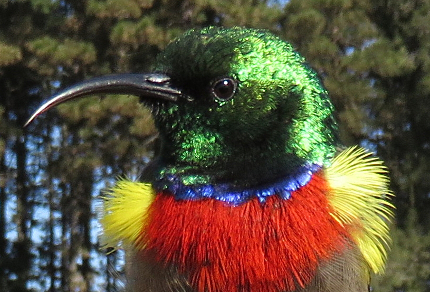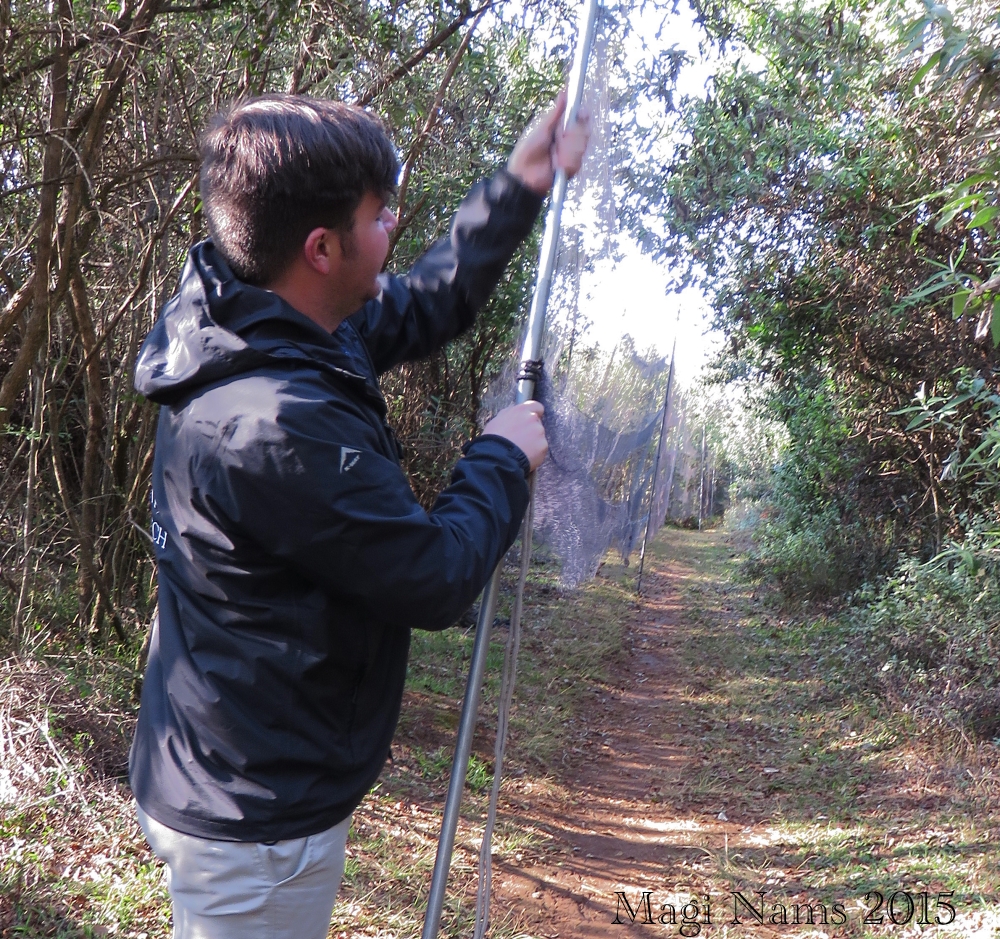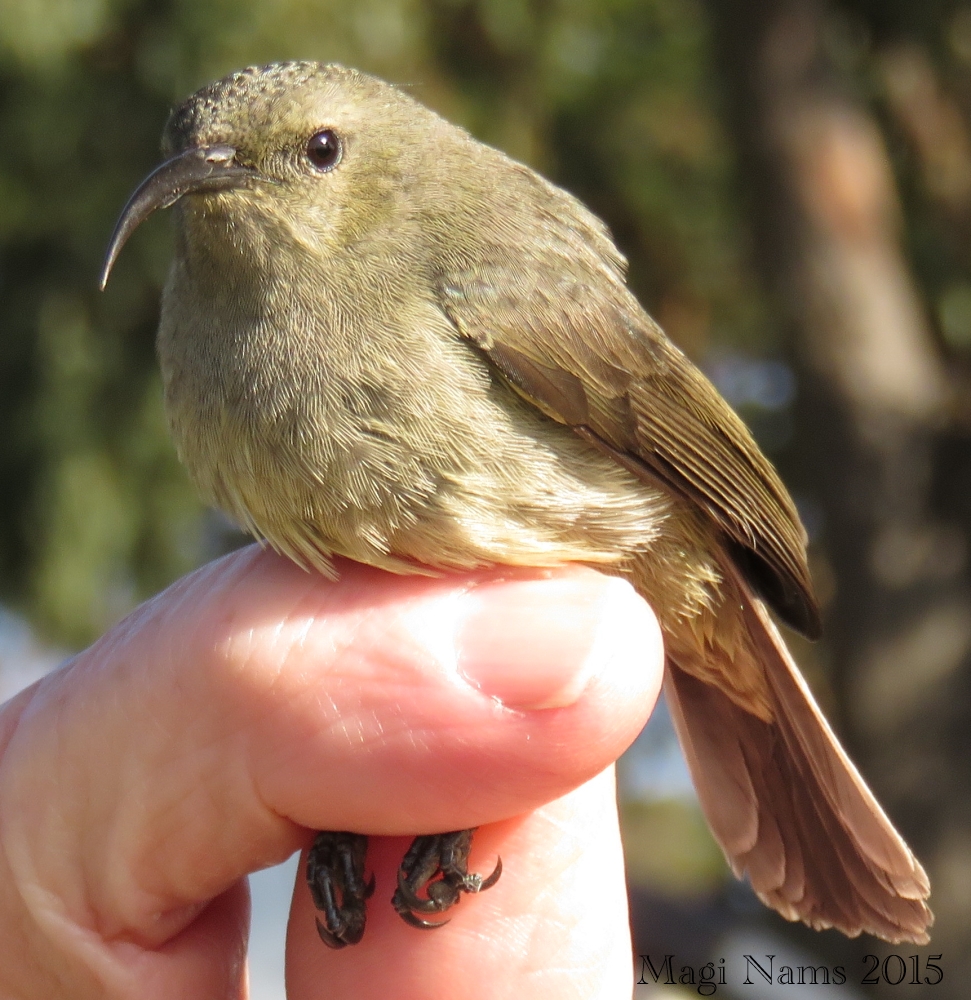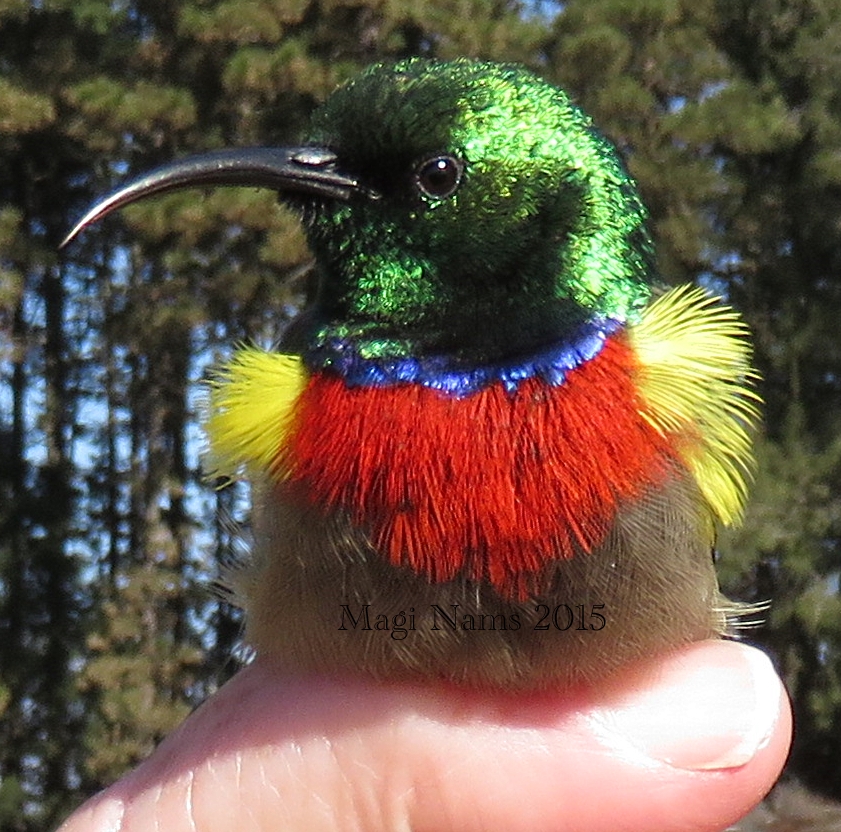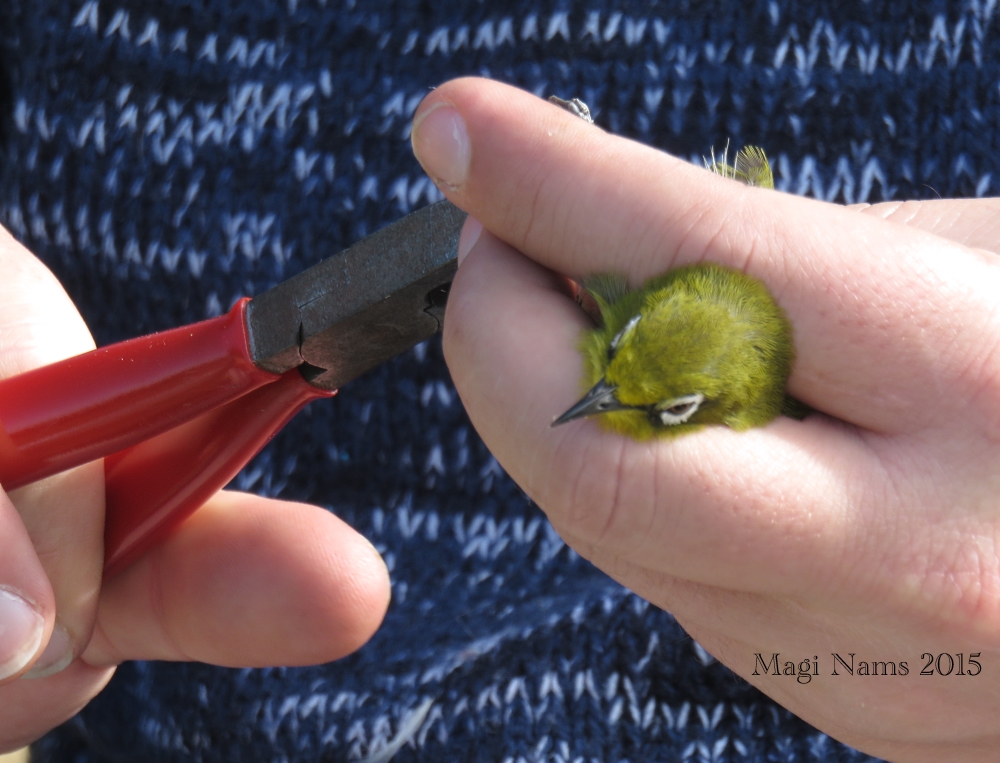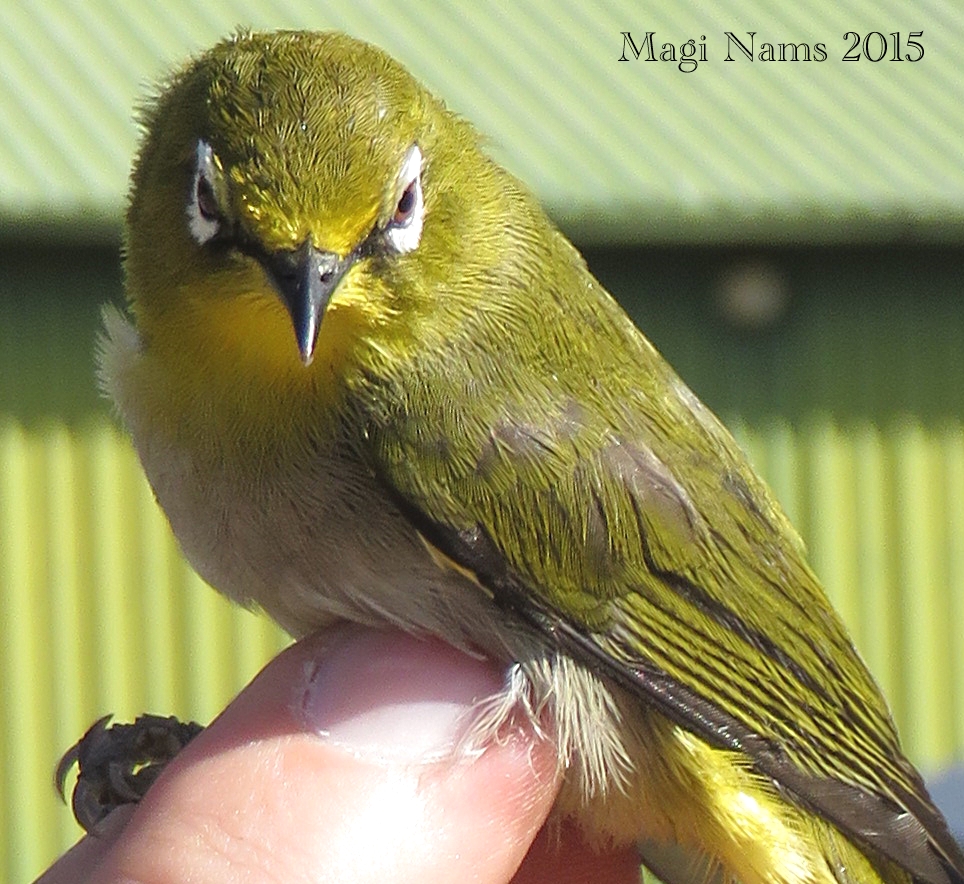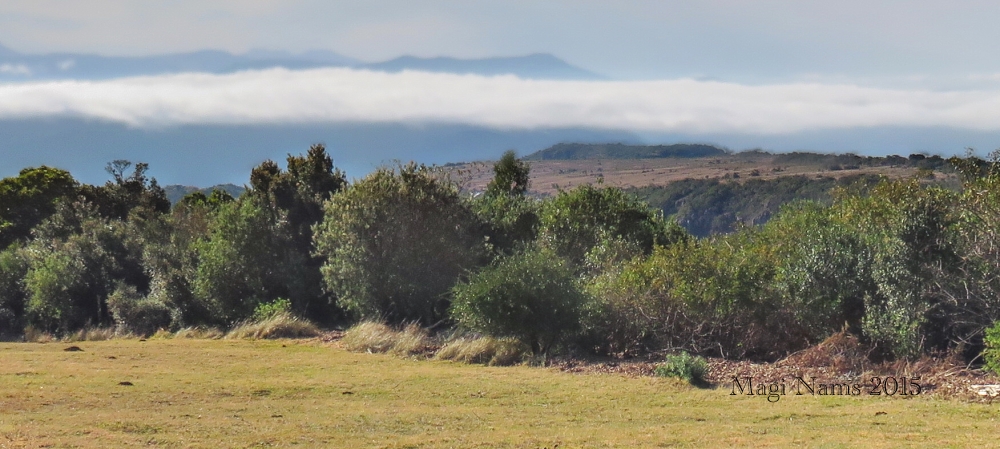Spectacular views of the Amathole Mountains capped a day of winter birding at Fort Fordyce Nature Reserve that yielded up-close views of Afromontane forest birds, including glorious male collared and southern double-collared sunbirds.
Yesterday, I tagged along with two Rhodes University ornithologists, Drs. Adrian Craig and Pat Hulley, and PhD student, Daniel Danckwerts, for a day of mist-netting and winter birding at Fort Fordyce Nature Reserve. Located on the Great Escarpment 130 kilometres north of Grahamstown, the reserve looks out over a vast landscape of forested mountains and deep valleys and ravines. On the northeastern horizon, the summits of Hogsback, Katberg and Winterberg in the Amathole Mountains jutted against the sky. Winterberg’s peak was white with snow – the first snow I’d seen in Africa. (Tap on photos to enlarge.)
While Pat set up a table and organized the ringing equipment, Adrian and Dan erected a line of nine mist nets along a trail through a patch of dense woodland adjoining the nature reserve headquarters. The nets were about 2 metres high and either 12 metres or 9 metres long. I carried the bag of nets and fetched poles and stakes, as needed. The morning was calm, sunny and warmer than I had expected, so it was a joy to work outdoors. Dan explained that the best conditions for mist netting are an overcast sky and no wind since then the nets hang still and no sunlight glints off them. We had the calm weather aspect but not the overcast aspect. Where shade fell on the fine black nets, they were nearly invisible; however, in sunlight they reflected a silvery shimmer that was undoubtedly visible to birds.
Soon after the nets were up, a female southern (lesser) double-collared sunbird flew into a net. Adrian extricated it, popped it into a cloth bag and carried it up the hill to Pat, who was seated at a table that held what looked like a large fishing tackle box filled with bird ringing supplies. Pat attached a tiny, numbered leg band, measured the sunbird’s wing length, checked for a brood patch (which would indicate the female was incubating eggs), checked feather condition and weighed the bird. The sunbird looked tiny and delicate in his gentle hands but winged away strongly on its release.
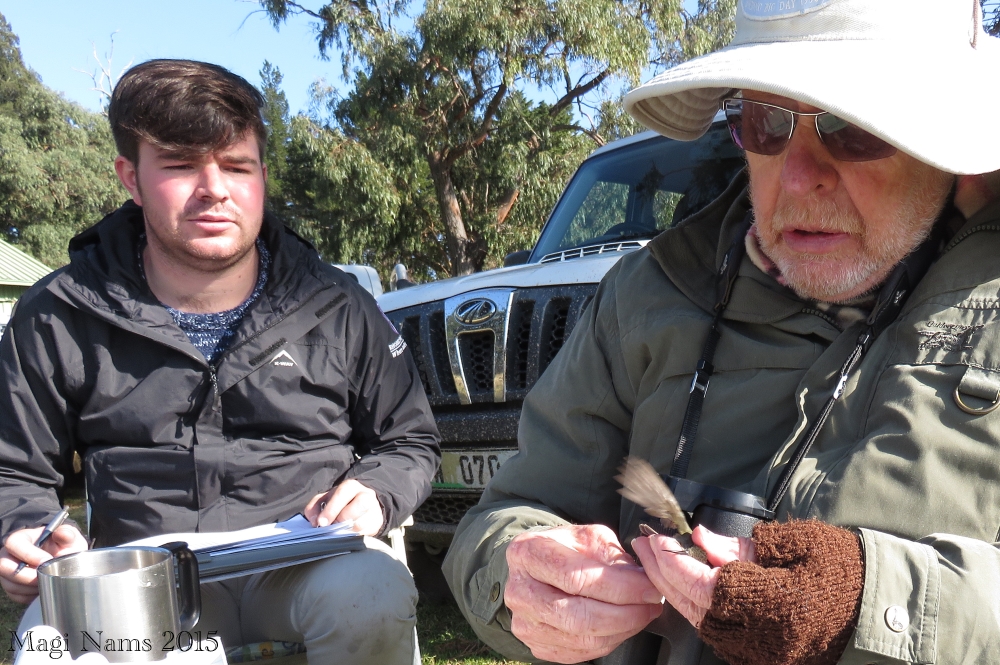
Dan Danckwerts records data while Pat Hulley rings a female lesser double-collared sunbird. (© Magi Nams)
While Pat monitored the nets, Adrian, Dan and I walked downhill through montane forest, seeking birds. Having led Rhodes University ornithology class field trips to the reserve since the early 2000s, Adrian began ringing birds there at regular intervals in 2007 to obtain long-term data. Eight years later, he has recaptured at least one bird five years after it was ringed. In addition to ringing birds, he and his work crews also list species seen and heard on the reserve during each visit.
As we walked through the forest, I had the benefit of Adrian’s and Dan’s expertise. They pointed out birds high in the forest canopy and made psshh-ing sounds to attract them closer for better views. Dan played bird vocalizations on his cell phone to draw the attention of territorial males. For me, that walk yielded an amazing treasury of South African birds. Alpine and black swifts sailed over a grassy area at the trail’s start. A Knysna woodpecker and grey cuckoo-shrike flew from tree to tree. A male blue-mantled crested-flycatcher with a black throat flitted from perch to perch, fanning its tail. A male collared sunbird – gloriously iridescent in shades of green and gold with a narrow purple chest band – darted out of the forest and perched in a tree at the edge of the trail, offering us spectacular views of it. And there were many more.
On our return to the nets, Pat had a surprise for me. A male southern double-collared sunbird had flown into one of the nets, and he’d banded it. He held it up for me, showing off its iridescent beauty. Stunning!
As we waited, seated on lawn chairs in the winter sun, the talk was birds, birds and more birds. We scanned the air, trees, shrubs and grass for more species. A chocolate-and-pumpkin-coloured chorister robin-chat repeatedly perched at the forest edge. A lazy cisticola with a rusty cap hopped into the open at the base of a shrub, flicking its tail up. Male and female amethyst sunbirds hawked for insects.
On one of the net checks, Dan returned with a Cape white-eye and ringed it. Afterward, he showed me the tiny white feathers that make up a Cape white-eye’s eye ring and offered me another great South African bird photo opp.
In the late afternoon, Adrian and Dan dismantled the nets as efficiently as they’d erected them, and Pat packed the ringing gear. For me, it had been an idyllic day. Not only had I spent an entire balmy winter day outdoors in pleasant company, I had added thirteen new species to my life list of birds and had seen springboks, a warthog, my first wild baboons, bushbucks, a caracal – what an exciting surprise! – zebras and black wildebeests during the drive to and through the reserve. On a day of winter birding at Fort Fordyce Nature Reserve, the Eastern Cape had laid out her riches in fine style.
My bird list for today: pied crow, Hadeda ibis, Cape crow, fork-tailed drongo, common fiscal, *southern double-collared sunbird, *alpine swift, *African black swift, (glimpse of Barratt’s warbler), Cape white-eye, *yellow-throated woodland-warbler, *grey cuckoo-shrike, *black-backed puffbird, *collared sunbird, *blue-mantled crested-flycatcher, *chorister robin-chat, *forest canary, amethyst sunbird, red-winged starling, *grey sunbird, lazy cisticola, greater double-collared sunbird, *black cuckoo-shrike, white-necked raven, *southern tchagra.
My mammal list for today: springbok, common warthog, *savanna (Chacma) baboon, bushbuck, *caracal, zebra, *black wildebeest.

